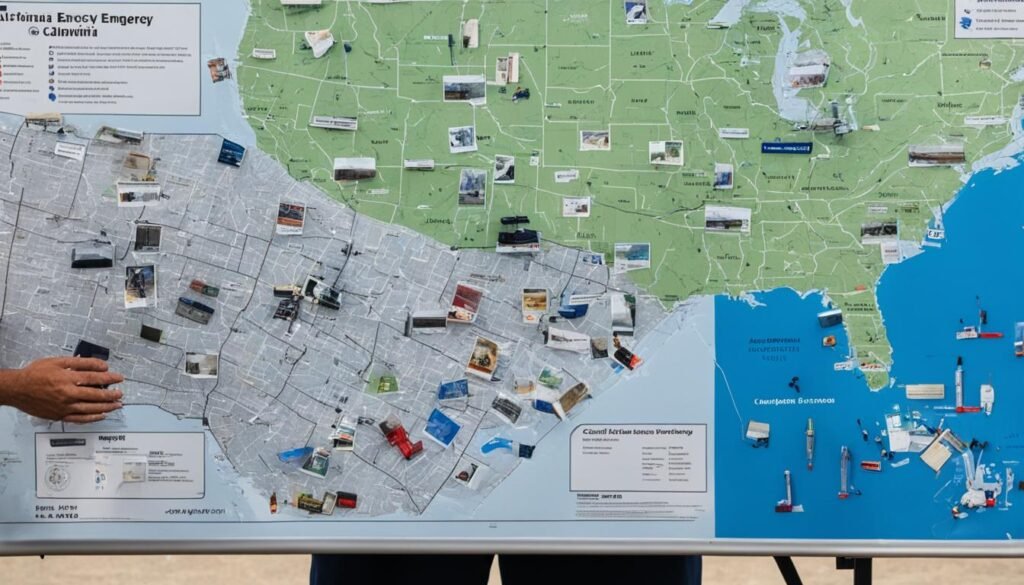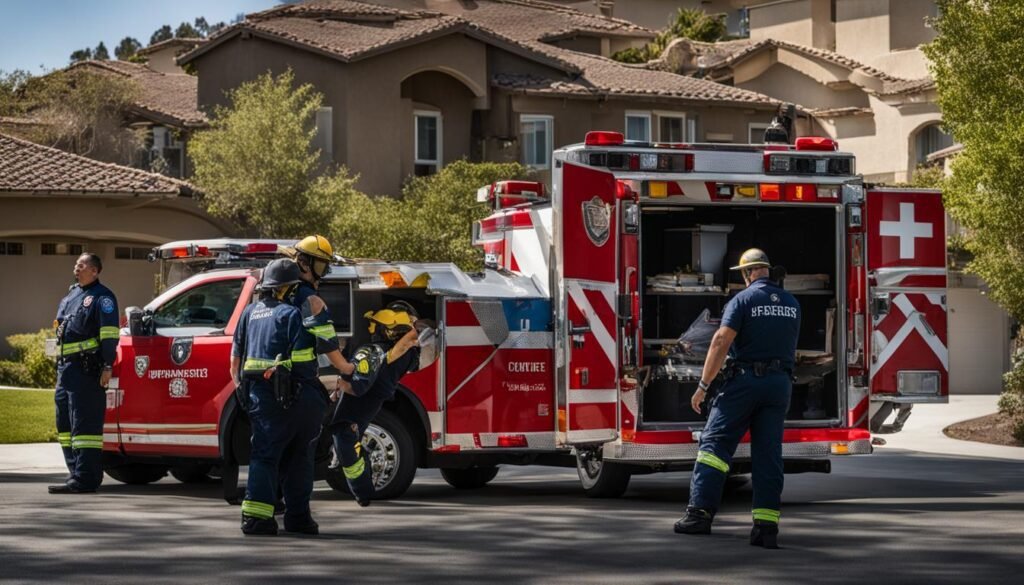Governor Gavin Newsom has declared a state of emergency in California in response to incoming winter storms. This emergency proclamation authorizes the mobilization of the California National Guard and supports relief efforts across the state. With heavy rain, snow, and strong winds predicted, the National Weather Service has issued warnings for potential flooding.
As residents of California, it is crucial for us to stay informed and take necessary precautions to ensure our safety and the safety of others. By staying informed about the current state of emergency and following the guidance provided, we can minimize risks and be better prepared in case of any emergencies.
Key Takeaways:
- California has declared a state of emergency in response to incoming winter storms.
- The emergency proclamation supports relief efforts and authorizes the mobilization of the California National Guard.
- The National Weather Service has forecasted heavy rain, snow, and strong winds, with potential flooding.
- Residents are urged to avoid non-essential travel, prepare emergency kits, and sign up for emergency alerts.
- Stay informed, be prepared, and stay safe during emergencies in California.
Emergency Preparedness and Response
The California Health and Human Services Agency (CalHHS) is actively collaborating with local partners to ensure the well-being of vulnerable groups impacted by the incoming storm. Our primary focus is on individuals with disabilities, older individuals, and unsheltered individuals who may require additional support during emergency situations.
In response to the state of emergency in California, various state departments are mobilizing resources to address the needs of affected communities. The Department of Social Services is prepared to establish shelters to provide temporary housing and essential services. The Department of Public Health is working closely with hospitals and healthcare facilities to ensure uninterrupted care for patients, while the Department of Health Care Access and Information is evaluating any potential impact on critical infrastructure.
To ensure swift emergency medical response, the Emergency Medical Services Authority has readied Ambulance Strike Teams, ready to be deployed as needed. We are committed to providing the necessary resources and support to safeguard the well-being of all Californians.
In order to prepare for emergencies, residents are advised to take proactive measures. It is crucial to have essential supplies on hand, including food, water, and medication, to sustain yourselves and your loved ones. Additionally, consider creating a power outage plan for any medical devices that rely on electricity. Monitoring food storage during outages is also recommended to prevent spoilage.
Key Recommendations:
- Build an emergency kit with necessary supplies
- Create a power outage plan for medical devices
- Monitor food storage during power outages
By staying prepared and informed, we can all contribute to a safer California in times of emergency. Remember, emergencies can happen unexpectedly, so it’s crucial to be proactive and have a plan in place. Together, we can navigate through these challenges and ensure the well-being of our communities.

Driving and Road Safety
During a state of emergency, it is crucial to prioritize road safety and minimize non-essential travel. To stay informed about the current road conditions, closures, and chain control, I recommend downloading the QuickMap app or visiting their website. QuickMap provides up-to-date information to help you plan your route effectively.
In times of severe weather, power outages may occur, causing potential disruptions to your daily activities. It is essential to be prepared with alternative power sources and have flashlights readily available. Additionally, make sure to check the functionality of your carbon monoxide detectors regularly to ensure your safety.
As part of your emergency preparations, it is advisable to consider food storage that includes nonperishable items. In the event of a power loss, having a cooler with ice will help maintain the freshness of your food for a longer period.
By following these road safety tips and being prepared for power outages, you can help protect yourself and your loved ones during a state of emergency.
Emergency Support and Recovery Functions
The State of California Emergency Plan (SEP) plays a crucial role in managing and responding to emergencies across the state. It provides a comprehensive framework for preparing, mitigating, responding to, and recovering from emergencies.
The SEP outlines the roles and responsibilities of various state agencies involved in emergency management. It specifies the methods for conducting emergency operations and mobilizing resources effectively. This ensures a coordinated and efficient response to emergencies.
One important component of the SEP is the California Emergency Support Functions (CA-ESFs). These functions encompass primary disciplines or activities that are essential to emergency management. Each CA-ESF brings together stakeholders from various sectors to collaborate and work together in different stages of emergency management, including mitigation, preparedness, response, and recovery.

Emergency Support Function Annexes further provide specific information and guidelines for different areas of emergency management. These annexes enable specialized and focused efforts to address distinct challenges that may arise during various types of emergencies.
By implementing these state of emergency protocols and following the guidelines outlined in the SEP and its annexes, California is better prepared to handle emergencies effectively and safeguard its residents and communities.
Conclusion
As a resident of California, it is crucial to stay informed and prepared during a state of emergency. By following guidance from government officials, signing up for emergency alerts, and taking necessary precautions, you can help ensure your safety and the safety of others.
Emergencies can happen at any time, so being prepared is key to mitigating risks and responding effectively. Stay updated on the latest information regarding ca state of emergency and california natural disasters. This will help you make informed decisions and take proactive measures to protect yourself and your loved ones.
Remember to stay informed about emergency protocols and guidelines. Follow the instructions of emergency personnel, and have a plan in place for your family’s safety. Prepare an emergency kit with necessary supplies and ensure you have alternative power sources during power outages.
During times of emergency in California, the state implements a robust emergency response system to manage the situation. By cooperating with emergency responders and supporting their efforts, we can collectively overcome the challenges posed by emergencies and work towards a swift recovery. Let’s stay vigilant, be prepared, and prioritize our safety and well-being.
FAQ
What does the state of emergency mean in California?
When the state declares a state of emergency, it allows for a coordinated response to a disaster or emergency. It mobilizes resources, authorizes relief efforts, and activates emergency response agencies to help ensure public safety.
Why has California declared a state of emergency?
California has declared a state of emergency in response to incoming winter storms, which are forecasted to bring heavy rain, snow, and strong winds. This declaration supports relief efforts and enables the mobilization of resources, including the California National Guard.
How can I prepare for an emergency in California?
It is important to have an emergency kit with essential supplies, such as food, water, medications, and first aid supplies. Stay informed by signing up for emergency alerts and have a plan in place for power outages and road closures. Follow guidance from government officials to ensure your safety.
Will there be road closures during the state of emergency?
Yes, road closures may occur during the peak of the storm. It is important to stay updated on road conditions, closures, and chain control. Download the QuickMap app or visit the website for current information.
What should I do in the event of a power outage?
If there is a power outage, it is important to have alternative power sources, such as generators or battery-powered devices. Keep flashlights handy and make sure your carbon monoxide detectors are functioning properly. Prepare your food storage with nonperishable items and have coolers with ice ready in case of power loss.
How does emergency support and recovery work in California?
California’s emergency management is guided by the State of California Emergency Plan (SEP), which outlines the process for preparing, responding to, and recovering from emergencies. The plan involves various state agencies and emergency support functions (CA-ESFs) that collaborate in mitigation, preparedness, response, and recovery efforts.







